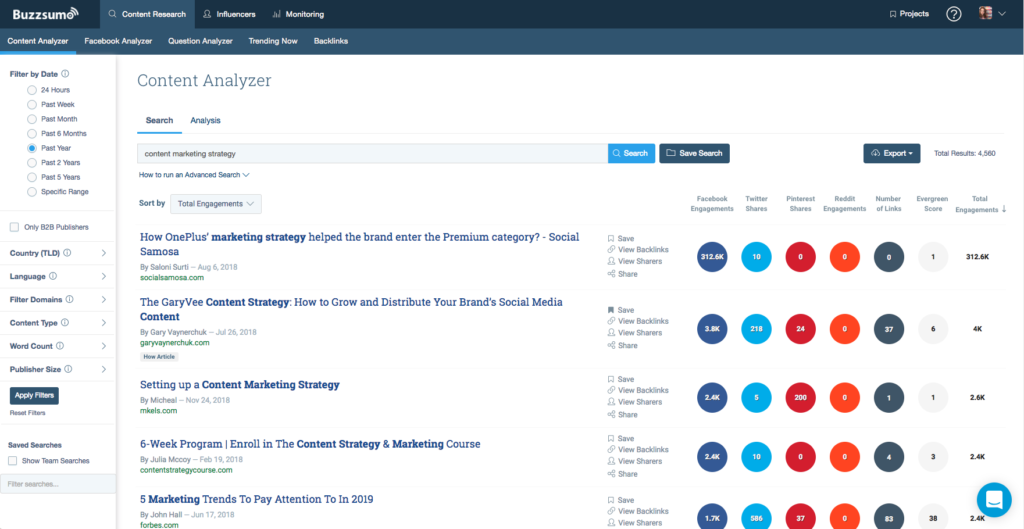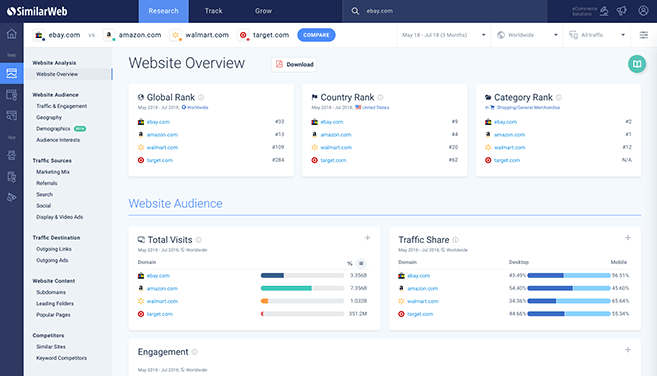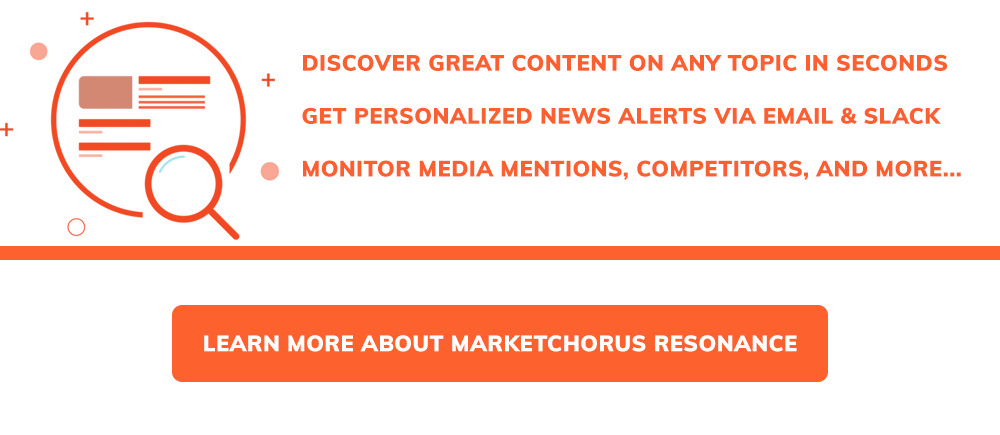It’s no surprise that AI is quickly integrating itself into every aspect of content marketing. We’ve covered that on the blog before, discussing all kinds of AI tools for content marketers and how they can improve your life, give you time back, and help you accomplish more.
Some of the challenges content marketers face are easier to solve with AI than others, since machine learning algorithms are still bleeding edge algorithms and this is still largely uncharted territory.
Content intelligence and competitor analysis were two of the first few applications of AI in content marketing to gain traction because these are very valuable activities but few marketers have the time to devote them without automation.
Sifting through Google Alerts for mentions of competitors is a time-consuming activity that PR agencies are better equipped to manage than marketers.
Replacing a traditional “press clipping” service with automated software would be a big advantage for marketers. Every dollar saved is a dollar you can put to better use somewhere else.
Analyzing competitor content, performance, and distribution can inform your content marketing strategy, saving lots of time that you’d spend brainstorming, researching, and optimizing your work.
In this post we’ll discuss several tools, including our own MarketChorus Resonance platform, that help marketers analyze competitor content at scale and implement the insights they find.
Here’s what we’ll cover, feel free to jump ahead:
[toc]Tracking competitor brand mentions in publications and social media
We probably all use Google Alerts in one way or another, tracking brand mentions across the public web, for reputation management, to attribute value to PR efforts, and other reasons.
And since we’re (probably) all familiar, it’s safe to say that we all also understand the inherent limitations of Google Alerts -and all the crap that you get with the good stuff. Worse, Alerts disregards most social media content making it useless when it comes to managing your reputation or listening for opportunities to engage on social networks.
Mention is a social media monitoring solution designed to solve this very problem by plugging directly into the social networks’ APIs, dissecting social mentions for context and sentiment, and reporting insights through a real-time dashboard.
Instead of manually searching for your brand repeatedly throughout each day on multiple networks, Mention pulls all this information together in a simple dashboard that allows you to research and take action quickly and seamlessly.

Image used courtesy of Mention.com.
Mention uses social media to discover content, so you’ll still have to rely on clunky Google Alerts for tracking brand mentions across the web as well.
A similar tool, called Mentionlytics, purportedly handles both activities for you in the same dashboard.
Monitoring social and web content mentioning your saved search terms in the same place reduces friction, improves the quality of reporting, and of course, helps you focus on what matters.
Analyzing high performance content in your niche
It’s easy to spot posts and tweets that have good engagement in the moment, as you’re scrolling through your social media feed, but very difficult to monitor performance of topics, or profiles, over time.
Manually tracking your competitors’ top performing content isn’t feasible. It would be a very boring full time job for someone on your team and isn’t worth the investment.
Fortunately, BuzzSumo has solved this problem with their content discovery platform. The paid version of their solution allows you to search for the top performing content by domain.
This means you can analyze your competitors’ highest performing content (by shares, likes, etc.) in just a few quick clicks. Studying this content can provide insight into the strategies that are working for your competitors
Beyond the number of shares, likes, etc. another key predictor of content performance is how influencers (influential social media accounts) are engaging with competitor content. Not to mention, discovering influencers that regularly promote competitors can lead to opportunities for conquesting their audiences.

Image used courtesy of G2Crowd.
BuzzSumo also reports on the influencers which have engaged with a particular piece of content, so as you find examples of exceptional competitor content, you can quickly export lists of engaged influencers for reaching out to with other automated tools like BuzzStream.
Reverse engineer competitor website analytics
Reviewing your content’s performance by analyzing your website analytics is one of the most important parts of any content marketing practice.
Which channels you invest in are driving converting traffic? What content is being consumed? For how long? These are the data points that drive the optimizations that improve results.
Imagine if you could apply the same types of techniques to your competitors’ websites and content…
How useful would it be to see your competitors’ top performing content? How much more effective could you be as a digital marketer if you knew what channels were driving traffic and leads to other brands in your space?
SimilarWeb is provides predictive analytics on any website to predict the volume of traffic, the global, country, and category rank (by traffic), and which sources are sending the most visitors.

Image used courtesy of SimilarWeb.
This feels a little like cheating on someone else’s test…but this is just par for the course for digital marketers. We’re all watching each other and copying the tactics we see working. You’ll do it to your competitors…and they’ll do it right back to you. No harm, no foul.
Let’s think about how this data can be used to inform your strategy…
If a major brand in your space is heavily focused on Instagram but you’re not established on that platform, you’d have the opportunity to evaluate your ability to compete before committing resources.
If you’re a fairly even match, it makes sense to try to cover any channels which are working for your competitors, to ensure they don’t develop a strategic advantage.
If your resources are limited and you’re trying to make an impact, it might be better to avoid channels where major players are already dominant. Instead you could identify the channels where they are weakest and lean in there.
Monitor competitor backlinks
There are lots of great options when it comes to SEO automation tools, like Moz, SEMRush, Ahrefs, Spyfu, and many others. Even Neil Patel’s Ubersuggest allows you to track a few keywords and see a sample of a domain’s inbound link profile (I’ll be using Ubersuggest for this example).
You should, of course, keep an eye on your site’s inbound links, but it’s out of context without also understanding your competition and how your domain authority compares to theirs.
If you’re not the biggest fish in your pond, then link building is still a critical activity for your marketing team. And even if you are, there are always other brands vying for attention. Link building is just a reality of modern digital marketing.
One of the best growth hacks among seasoned SEOs is mining competitor link profiles for insights and opportunities to feed automated link building efforts.
The idea is simple, though the execution is admittedly a bit technical. First make a list of competitor websites and search each of them in your SEO tool of choice. The result will be a list of web pages which link to your competitors.
Spend some time with the list for each competitor, making note of links which you could theoretically replicate. Create a list of the publications, Wikipedia (depending on your circumstances), podcast websites, social media profiles, news sites, PR newswires, and on that you discover in your research.
Some of the links will give you immediate insight into your competitors’ marketing strategies.
Are they launching a new podcast? Check out the list of upcoming guests for potential influencers and guest blogging opportunities.
Are there a lot of links from one publication? Visit the pages where the links originate. Is the author employed by the competitor? If so, you’ve learned something about their thought leadership strategy. If not, see if you can build a relationship with this author as well!
This process can expose a wealth of competitive insights as well as provide inspiration for your future content marketing and link building efforts. If a strategy is working for your competitors, put it to work for you!
Track social engagement on competing content
Social media can feel a lot like screaming into the void most of the time. It’s hard to tell if your own efforts are having any effect sometimes. It’s even harder to monitor all the competing content in your space for insights and opportunities.
Wouldn’t it be great to be able to spot topics that are gaining traction in your niche before they’ve become trends and everyone is already on jumping on the bandwagon?
Timeliness is one of the big challenges in content marketing that has AI software brands like us excited.
MarketChorus is hard at work developing tools to help brand publishers discover relevant emerging trends from the overwhelming amount of information the world produces every day.
Our Resonance platform indexes thousands and thousands of popular publications every hour of the day and scours social media for insights on the articles it discovers. A quick search of any topic will return the content that the world is reading, sharing, and engaging with relevant to that topic.
From there you can dig deeper into any topic, track your searches over time, and create audiences of social accounts that are consuming and sharing any of this content at the click of a button.
Promote your content to audiences that are already reading and sharing similar articles. Mine these audiences for influencers and promoters who might distribute your content. Follow everyone in the hopes they follow you back.
Export lists of the key terms which people are engaging with for use in SEO and SEM planning. Map these terms to long-tail Facebook interests to create contextual lookalike audiences for prospecting campaigns.
There’s a lot you can learn by analyzing what’s currently holding the attention of a digital community, which content creators are leading the discussion, who is listening, and who is taking action in response.

What’s the larger role of AI in content marketing?
Content intelligence is only one of the early applications of AI that are generating buzz among forward-looking marketers. But AI is quickly integrating itself into every aspect of content marketing.
From discovery to predictive analytics to content creation, promotion, and amplification; machine learning algorithms are replacing more and more repetitive, manual tasks that weigh marketers down and cost valuable time.
The future is full of possibility and it’s anyone’s guess where this wild ride will take us over the next few years; but the immediate opportunities are exciting enough without worrying about the horizon ahead of us.
Content discovery (research) and curation to support a corporate content marketing program are massive undertakings today and one that never really ends. If you’re committed to creating and sharing content, you have to keep creating and sharing day after day.
If you’re managing these efforts manually you have to commit dozens of hours each month. But if you can leverage AI tools like the ones mentioned in this post, you can cut that investment down to a few hours, a couple times a month.
Regardless of how you feel about AI actually writing copy, instead of human writers, you can’t argue with the benefits that machine-assisted writing provides. Human copywriters make grammar mistakes that can be cleaned up in real-time by tools like Grammarly.
Automatically optimizing headlines, email subjects, ad copy, and social content based on predictive analytics has already been shown to outperform human-written copy in some case studies.
More data-driven / less creative copywriting scenarios like these are on the bleeding edge of AI technologies in content marketing; but sooner or later, these will be mainstream too.
The reality is that machine learning algorithms will rapidly become inseparable from day-to-day content marketing activities. The scale at which marketers will be forced to function will soon be inconceivable without machine assistance.
As with any emerging trend, the most exceptional benefits are bestowed upon the early pioneers who forge boldly into new territory. Wait too long and you’ll simply be doing what everyone else is already doing. Act boldly in the months leading up to the AI revolution and you’ll be in position ahead of your competitors.
After all, fortune favors the bold…




